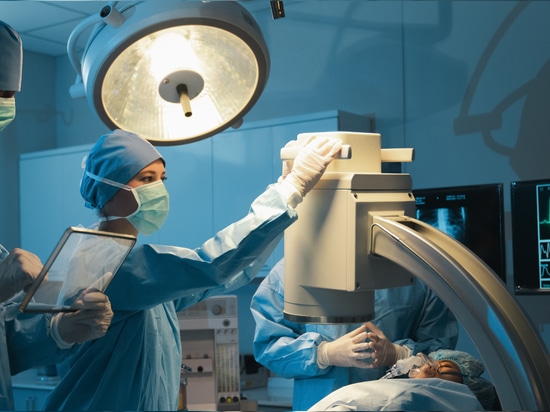
#Industry News
Investing in Quality: Why OR Equipment Matters in Healthcare
Fulfilling your OR's with top-of-the-line equipment like medical computers
Over 300 million surgeries are performed yearly, with US surgeons performing around 64 million. Hospitals equip their surgical teams and operating theaters with the best possible tools and equipment to maximize each surgery's success. Today's article will review the most essential types of operating room equipment, including their purposes, uses, and benefits.
Core Operating Room Equipment
Operating rooms must have specific medical equipment to function correctly. These five are considered core equipment for ORs.
Operating tables, also called surgical tables, play a crucial role in providing patients with a safe and stable platform during medical procedures. These tables are versatile and can accommodate a wide variety of surgical procedures. In addition to general-purpose tables, there are specialty-specific tables designed for orthopedic and neurosurgical procedures. Surgical table accessories like arm supports enable surgeons to position patients effectively, ensuring safer and more accessible surgeries.
Surgical Lights: Surgical lights provide the necessary light to illuminate the operation site while eliminating shadows. Today, many older halogen lights used in ORs have been replaced by brighter, more energy-efficient LED options. These new surgical lights last longer, emit less heat, provide more accurate color rendition, and have better shadow control.
Anesthesia Machines: Anesthesia machines play a vital role in inducing a state of controlled unconsciousness in patients. These devices, also called anesthesia workstations, anesthesia delivery systems, and anesthesia carts, are essential for ensuring the safety of patients undergoing medical procedures. For instance, the machine's flow meters, vaporizers, ventilators, and pressure gauges work together to deliver a precise combination of anesthetic gases and oxygen to the patient. Furthermore, medical-grade monitors provide real-time updates on the patient's vital signs, while alarms for hypoxic mixtures and oxygen failure promptly alert the surgical team to any unexpected issues or complications that may arise.
Electrosurgical Units (ESUs): ESUs or Bovie machines (named after its creator, William Bovie) allow surgeons to cut and cauterize tissue with electricity, which minimizes bleeding. Electrode pads ground the electricity traveling through the patient's body. Other modes allow more delicate work, like brain surgery.
Surgical Instruments: The surgical instruments are a crucial part of the five core essential operating room equipment. These instruments are of utmost importance as they enable surgeons and their teams to perform procedures with precision and care directly. At a minimum, the OR should stock:
Forceps to grip, hold, or move tissue and other objects during surgery
Hemostats to stop bleeding, especially from small blood arteries
Retractors to pull back cut tissue
Scalpels to make incisions
Suction devices to keep the surgical area clear of fluid during surgical procedures
Surgical clamps to keep cut tissue in place or to stop blood flow
Surgical needles and sutures for closing incisions and wounds
Surgical scissors to make precise cuts
Maintenance is critical for these high-quality surgical instruments. Cleaning processes like sterilization via autoclaving ensure safe use during procedures. The cleaning processes also ensure their longevity. For example, using surgical instrument lubricants instead of saline solutions prevents possible corrosion, ultimately weakening the instruments.
Supporting Equipment
Supporting equipment consists of tools and devices that play vital, yet indirect, roles in surgical success. Here are four examples.
Surgical scrub sinks: Surgeons and their teams use these to scrub their arms and hands of pathogens, reducing the chance of transmitting healthcare-associated infections (HAIs) to patients.
Medical gas systems: These machines supply the patient with oxygen, nitrous oxide, and other gases. These systems also supply specific OR tools that run on compressed air. (The anesthesia machines above regulate the gasses being administered to the patient).
Storage and mobility solutions: Efficient storage solutions are crucial for surgical teams, as they enable quick and convenient access to essential medical supplies and operating room equipment such as surgical gowns, sponges, and gauze pads. These storage solutions come in various forms, including stainless steel cases, cabinets, and surgical carts.
Nurses Station: This is the workspace in the surgical centers where nurses coordinate care for patients before and after their surgeries. Nurses often enter necessary documentation here, including updating patients' EHRs with surgical information.
Computers and Monitoring Systems
Thanks to the digital transformation of healthcare, computers have been added to many essential operating room equipment lists and guides. Core OR equipment like the previously covered anesthesia machine already uses a medical box PC to control vital functions.
Other operating room functions where computers are included:
Medical-grade computers: Surgeons may bring up patients' electronic medical records (EMR) on their medical PC to review everything from medications to developing pre-op surgical plans. Surgical teams may track surgical equipment via their medical tablet's built-in barcode scanner to ensure nothing gets lost in the patient's body before closing.
Regardless of use, medical-grade computers built with features like 60601-1 certification for patient safety, fanless design, and IP65 sealed front bezel ensure the medical computer and tablets can function just fine in the sometimes unforgiving environment of the OR.
Surgical monitors: Surgical teams encounter a wide range of intricacies when dealing with anatomical features that are either too minute to be visible to the naked eye, such as many veins, or exceedingly delicate, such as the cornea of the eye or the brain. It is essential for specific surgical procedures, such as minimally invasive surgery, to have access to the requisite resources to be successfully performed.
High-definition and 3D monitors become essential in these operations. Their high resolutions and anti-glare filters allow surgeons to see such operation sites clearly, even under bright surgical lights. 4k medical computers and displays bring up the fine details from X-rays and ultrasound scans. The information helps surgeons in pre-op as they can view tumors and other masses beforehand and adequately plan for them.
Integrated Operating Rooms: A form of Internet of Medical Things (IoMT), integrated operating rooms link medical-grade computers, medical-grade monitors, and medical devices like anesthesia machines into their network.
The advantages are many. Advancements in surgical technology have made it possible for surgeons to conduct minimally invasive procedures with the assistance of robotic systems. These surgical-assistance robots have robotic limbs that enable precise and controlled movements during the operation. Additionally, remote medical specialists can provide real-time guidance to on-site surgeons, offering expertise and advice on specific surgical techniques without needing physical presence in the operating room. This innovative approach eliminates the necessity of transporting patients to distant specialists or bringing the specialists to the operating room, resulting in significant time and cost savings. Moreover, reducing the number of personnel directly involved in the surgical procedure minimizes the risk of surgical site infections.
Let Cybernet Fulfill Your OR Computer Shopping Needs
To ensure smooth and efficient surgeries, operating rooms must be equipped with top-of-the-line medical computers that are specifically designed for the healthcare industry.
Contact a staff member at Cybernet Manufacturing to fulfill your OR's computer needs. Our All-In-One PCs, box PCs, and tablets are built from the ground up to be effective in demanding environments like the OR. As an Original Design Manufacturer, we can customize our specialized computers to your needs.







